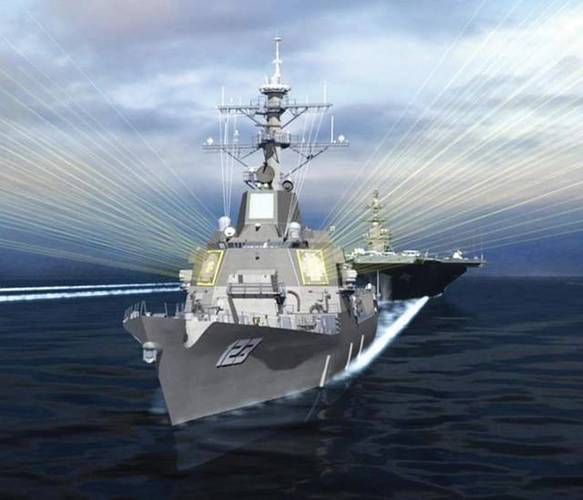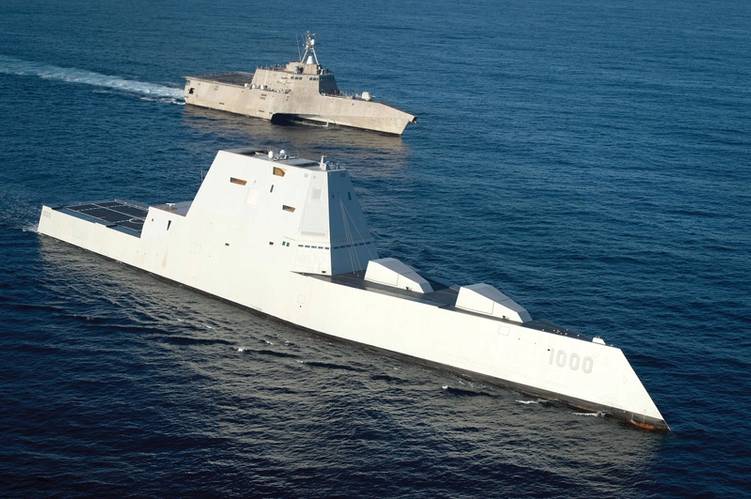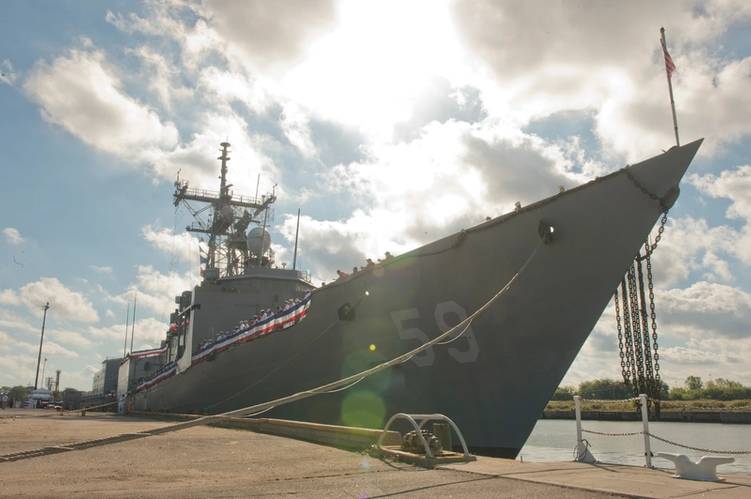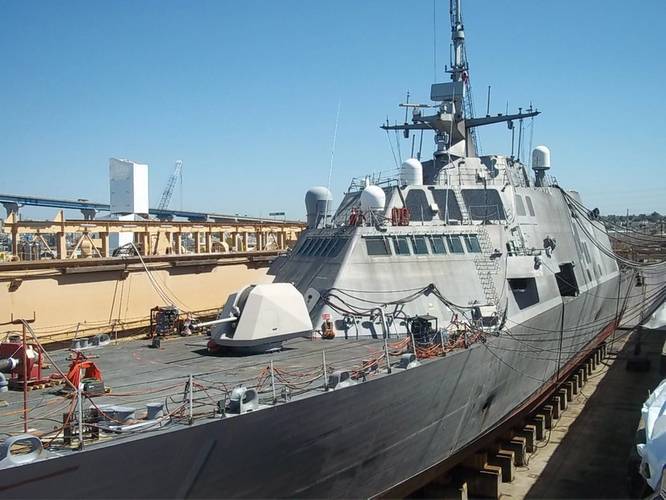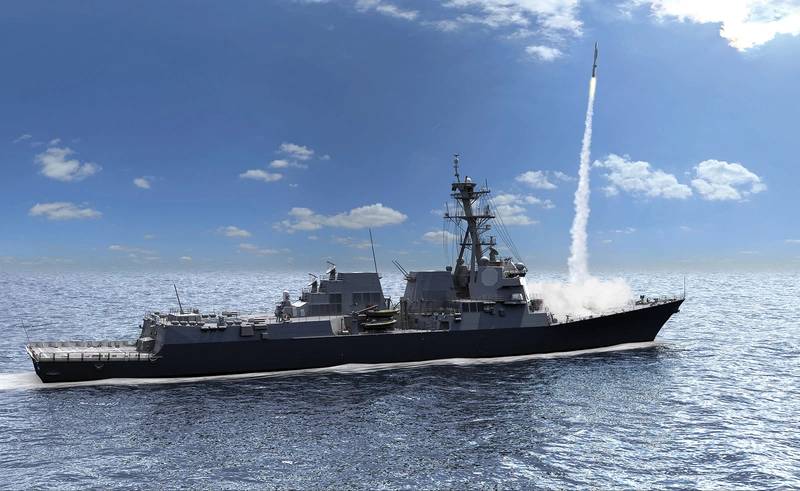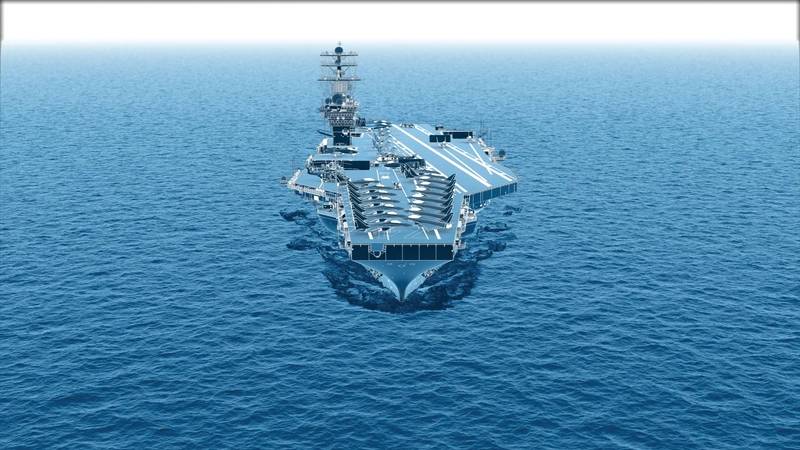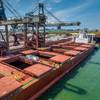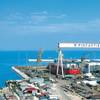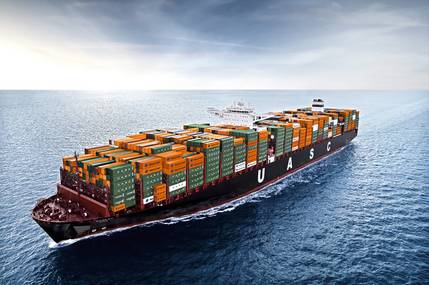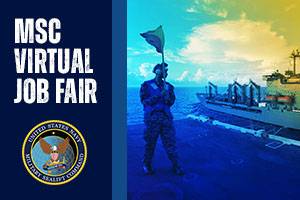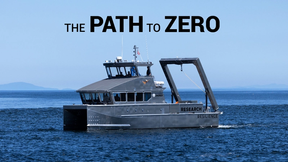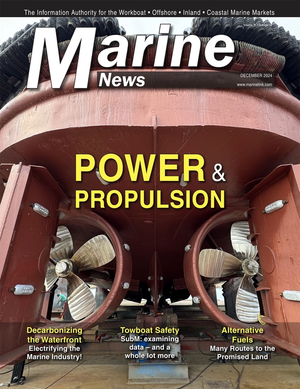Navy of the Future: The Revolution & Evolution of Surface Combatants
Following the drawdown at the end of the Cold War, the Navy finds itself trying to build up again. The expansion of Russian and Chinese naval power has changed the calculus.
While there will always be a debate about the final number of ships to build, we can all agree on one thing: the Navy must get bigger and the demand signal is to start building now,” said Chief of Naval Operations Adm. John Richardson, in testimony before Congress regarding the sea service’s 2019 budget request. “The Navy (needs) a better fleet, more capability achieved through modernization, networking, agile operating concepts, and a talented force of sailors and civilians with officers of competence and character to lead them. And finally, the nation requires a ready fleet: more at-sea time, more flying, more maintenance and more weapons of increased lethality that go faster, farther and are more survivable.” A tall order indeed, with the main question remaining: From where will the money come?
Designing, Building, Maintaining the Future Fleet
For the U.S. Navy, designing and building the fleet of tomorrow has always been heavily influenced by the past and present. That goes for the technology on the ships to the industrial capacity to produce them. It takes years to build a ship from design to construction before entering the fleet, especially the first ship of a class. Making the design and build particularly challenging is the fact that a lot of technology changes from initial drawing to commissioning, particularly today with the acceleration of technology change. That’s why building tomorrow’s Navy will require a different approach. One critical point to always keep in mind: The industrial capacity to design, build, outfit and maintain a naval force is not a faucet that can simply be turned on and off.
Commonality Matters
The Navy is now planning for a large surface combatant and a small surface combatant, referred to as the frigate.
“When we think about the distribution of our force, we need capacity, so we need some things to be big and some things to be small, and figuring out how we can balance capacity and cost and distribute those sensors and shooters most cost effectively within our force,” said Rear Adm. Ron Boxall, director for surface warfare on the OPNAV staff.
The large surface combatant will take the DDG 51 Flight III combat system and place it on a larger hull, with the space, weight and power for mission growth. The frigate is also moving forward, with five industry teams under contract for conceptual work. “They’re working with our program offices to mature the system specification and the individual designs, inside the cost parameters that we’re looking for to make that small surface combatant a common, networked, surface platform to do both sensing and shooting, and common to the large surface combatant and our unmanned platform or platforms,” said Boxall. “We’re using a lot of government-furnished equipment (GFE) systems that we already know, so we’re not bringing a lot of uncertainty in.” While the frigate will leverage an existing design, the large combatant would require a new design with the appropriate size and power.
Boxall said that unmanned systems are another way to distribute the force and build capacity. “We need things to be as small as they possibly can be, but big enough to do what they need to do.”
“At the small surface combatant level, that force needs to have capacity at a cost, but it’s got to be able to sense and shoot and do command and control, and that just won’t have as big a sensor, it won’t have as much capacity to shoot, but it will still have that same common combat system,” Boxall said. “So that’s why commonality matters. It’ll have the same radar as the large surface combatant. And the same thing if you look at the unmanned platform, it might be a sensor, or shooter, or something in between – a command and control node, but not all of those things.”
There has long been the desire to create a “common hull” that could be configured as needed. The benefits are obvious, with reduced design and fabrication costs and commonality for spares and training. But the promise has been elusive. There are so many tradeoffs, that the result is a compromise that is never optimal for any one mission.
There are examples of system commonality that has saved money and allowed for more efficient use of manpower, training and support.
• CGs and DDGs have similar sensors, guns, launchers and missiles.
• The replacement for the Whidbey Island class of LSDs will be based on a lesser capable version of the San Antonio class of LPD. There will be advantages in commonality, and cost savings in design and construction by avoiding an entirely new design.
• Italy and France have built their FREMM frigates with a common hull, but with general purpose and ASW variants. Likewise, Denmark’s frigates and flexible support ships are basically two variants of the same common hull, with one ship designed for multi-purpose missions and the other for ASW and AAW, using the same Terma C-Flex combat management system.
There is commonality between the Lockheed Martin Aegis combat system on U.S. Navy guided missile cruisers and destroyers, and anti-air warfare ships of other allied navies, and the COMBATTS 21 system on the Freedom variant of LCS, which is based on Aegis. Likewise, the Independence variant of LCS uses Tacticos, a variant of the Thales Tacticos system found on many naval vessels. The total ship computing environment on Independence is similar to the one found on the Spearhead-class of expeditionary fast transports, both provided by General Dynamics Mission Systems.
Modularity is another way to achieve commonality. Adaptive force packages, including systems and operators like the General Dynamics Knifefish or Kongsberg MK 18 mine countermeasures systems — can operate from LCS, or another platform, such as the EPF.
Capability Evolution
For several generations of U.S. Navy combatants, the subsequent classes of ships were adapted from previous classes and carried something new forward. But the ships were not entirely transformational.
The Dealy (DE 1006) class was the first post war DE purpose-built for ASW. They were not highly capable, but they were followed by the Bronsteins. The Bronstein (DE 1037) class of escort ships had new sonar and ASW weapons, which was then installed on the Garcia (DE 1040) and still larger Knox (DE 1052) class of escorts. Everything on the 1037 was on the 1040, except the 1040 was more seaworthy. The Garcia class frigates had proven guns and ASW systems, but a new power plant, which was carried forward to the Brooke (FFG 1) class of guided missile escorts, but not subsequent ships. Like the Bronsteins, there wasn’t much margin for growth. The Knox and slightly modified Joseph Hewes (DE 1078) classes had much more room. The Spruance (DD 963) class destroyers had an updated weapon system from the earlier Forest Shermans, but with a larger hull and entirely new gas turbine propulsion system. The search radars and sonars weren’t new but the Mk 86 fire control system was new and the SPG-50 and SPQ-9 radars were a new leap. And the Spruance class had plenty of room, and allowance for more weight, along with great power excess, making it logical to use the Spruance platform for the Ticonderoga (CG 47) class guided missile cruiser and its revolutionary Aegis combat system.
Oliver Hazard Perry (FFG 7) guided missile frigate was a 20-year “throwaway” ship with a small crew, with no margin for more capability or more people. It was designed for open ocean convoy escort duty, but not one FFG ever performed that mission. Like other frigates, with top speeds of less than 30 knots, the FFG 7s were speed limited in battle group operations. However, the fact that it had two helicopters and received a towed sonar system made it a valuable asset. And they became a valuable utility player in battle group operations. With a shallower draft than the DDG 51s, they could enter more ports than other combatants, and were better suited for detached assignments such as maritime interdiction operations than larger, more capable ships. They lasted 35 years instead of 20.
The Ticonderoga (CG 47) class guided missile cruisers were built on the Spruance hull (the hull and engineering was almost identical). The first five CG-47s were decommissioned well before they reached their expected service life because they just couldn’t be affordably upgraded with the vertical launch system (VLS).
The Arleigh Burke (DDG 51) class of guided missile destroyers essentially takes the CG 47 combat system and places it on a new hull. An effort to lower construction costs called for reducing the amount of steel required to build it. That made it compact, which reduced room to grow, and often made it difficult to perform maintenance in confined spaces. A later Flight II version was a little bigger, and the added helo hangar allowed an air detachment to be embarked. Now the Flight III version is underway, with a new sensor suite.
There are many more examples of evolutionary development, such as converting World War II cruisers into missile ships, the development of the Stand missile family of surface ship weapons, and the introduction of nuclear power for surface combatants. And this article does not focus on the emerging technologies, such as directed energy weapons and unmanned system, which will certainly alter the trajectory of surface ship development.
In most of these cases, there was innovation combined with something tried and true-revolution and evolution. That was not the case with the Zumwalt (DDG 1000) class DDGs, in which everything was new and different.
New is Old
Even the most modern warship is, in some ways, obsolete when it is commissioned. As the new DDG 1000 guided missile destroyers enter service we can appreciate all of the “new” technology that has gone into those ships. But the concept for those ships is not new.
To understand the genesis, we need to go back to 1987, when Vice Adm. Joe Metcalf, the Deputy Chief of Naval Operations for Surface Warfare (OP-03) on the Navy staff stood up two study groups—the Ship Operational Characteristics Study (SOCS) and the Surface Combatant Force Requirement Study (SCFRS)—to examine the operational characteristics required of surface combatant and how many would be needed respectively.
The SCFRS (pronounced “skiffers”) report assessed and validated the numbers, types and capabilities of surface combatants needed during the coming quarter century, while SOCS studied the required operational characteristics those ships would need to meet the forecast threat.
The SOCS study took a fresh look at legal, institutional, operational and cultural factors that resulted in surface combatant designs, and the operational and maintenance practices that drove manpower requirements.
One of the ideas to come out of these studies was the “arsenal ship,” which later morphed into the SC 21 (surface combatant for the 21st century), and then the DD 21 land attack destroyer. In 2001 DD 21 was cancelled but it was resurrected as DD(X). As the Navy would stop building the Arleigh Burke class of DDGs, the Navy could focus on DD(X), and a follow-on cruiser, CG(X). The contract for the first DDG 1000, now called the Zumwalt class, was signed on Valentine’s Day of 2008. It was to be the first of 32 ships. They would be optimized for strike warfare to support expeditionary strike groups. That number was pared to 24, then 12, then seven, then eventually just three. As with most new ship classes, the first ship took a long time to build, with General Dynamics Bath Iron Works investing heavily in creating a facility that could build these ships.
USS Zumwalt today embodies the ideas first proposed in SOCS almost three decades ago. The ship has integrated electric propulsion (generating 78 MW of power); smooth topside spaces with embedded antennas; a high degree of automation and resilient electrical, communications and fire main distribution. Just as SOCS recommended, while Zumwalt has a bridge for conning, it is completely enclosed, and cameras and microphones provide sensory awareness for the watch team. The 80 vertical launch cells are located around the periphery of the ship for survivability. The two 6-inch guns retract into a stealth housing. It’s quiet and stealthy. It has the radar cross section of a fishing boat. Automation has reduced crew size from 300 on a 9,800 ton DDG 51 to 147 on a 15,800 ton DDG 1000.
Was the investment in all that new technology worth it?
If one looks at the three Zumwalt class ships as research and development platforms, then some very useful technology has come to fruition that will ultimately find its way into future naval ships. But it’s hard to look at the vision that began back in 1987, and pursued for so many years, and feel satisfaction that the vision has become a reality.
About the same time as DD(X) was evolving into the DDG 1000 program, the concept of LCS was being introduced. The littoral combat ship was supposed to be a simple platform with lots of volume for interchangeable combat capability that could address the Combatant Commanders’ most significant asymmetric threats in the littoral. It was to a “truck,” that you loaded up as needed. Again, it took some time to get the first few ships into the fleet, but those teething pains are behind us, and both variants (the monohull being built by Lockheed Martin and the trimaran being built by Austal USA) are in serial production. 32 will be built, and there are already a significant number of them in the fleet.
Lessons learned in developing DDG 100 and LCS will influence future generations of warships. But can we evolve and adapt fast enough to put the right ship in the right place tomorrow?
Industrial Capacity
With the current fleet size well below 300 ships, and a goal of 355, there is the issue of the industrial capacity to be able to build that many new ships. There is a dearth of domestic industrial capacity to design and build ships, and field them in a timely manner. There are only two yards building DDGs today, two building submarines, two building LCS, and one building carriers and one building amphibs. Presumably they could make adjustments and hire the workforce to dramatically step up production.
But what about maintenance, modernization and repair?
More ships means more maintenance. Any effort to grow the fleet will also include keeping useful ships around longer. A ship with a 30-year expected service life usually has a planned mid-life modernization to bring it up to date. An additional modernization availability could keep her for another decade or more. The Navy now plans to extend the service life of the entire class of DDGs to 45 years, which means more shipyard capacity is needed to accomplish those overhauls.
The Optimized Fleet Response Plan (OFRP) was designed to align strike group deployments with maintenance availabilities training and workups and to provide predictability and stability for Sailors and families, not to mention the training commands and maintenance and repair yards.
There are just a few players who have the pier space, cranes, dry docks and shops to handles U.S. Navy ships. There are some commercial yards that could start to take on Navy work, and there are some smaller companies that could bid on contracts and go to the bigger yards for the docking or other work that requires the serious infrastructure to accomplish. But like construction, this is not something light can be turned on with the flick of a switch.
Very few yards have dry docks big enough for large naval vessels, and that includes Navy owned dry docks. There is discussion on procuring a new dry dock for the Navy. Most large dry docks today are built in China. A Navy dock would have to be made in America. But most U.S. yards don’t have the ability to build a large floating dry dock. And even if there is capacity, it must be closely scheduled far in advance to fully utilize the significant investment. And while the Navy has strived to execute the OFRP, in reality the maintenance is contracted piecemeal.
Value of a Strong Industrial Base
The U.S. Navy had experience at the end of WW II to be building one class of ship, and embarking on the next improved iteration before the previous design was complete. This was possible, in part, because there was sufficient industrial capacity to have multiple shipyards working at the same time.
Fletcher (DD 445) class destroyer
175 completed / 13 canceled / 11 yards
Gearing (DD 710) class destroyer
152 planned / 98 compl. / 54 canceled / 9 Yards
Allen M. Sumner (DD 692) class destroyer
70 planned / 58 built / 6 yards
Charles F. Adams (DDG 2) class guided missile destroyer
23 built for the USN, plus three for Australia and three for Germany / 6 yards
Spruance (DD 963) class destroyer
31 built / 1 yard
Arleigh Burke (DDG 51) class guided missile destroyer
68 so far / 82 planned / 2 yards










